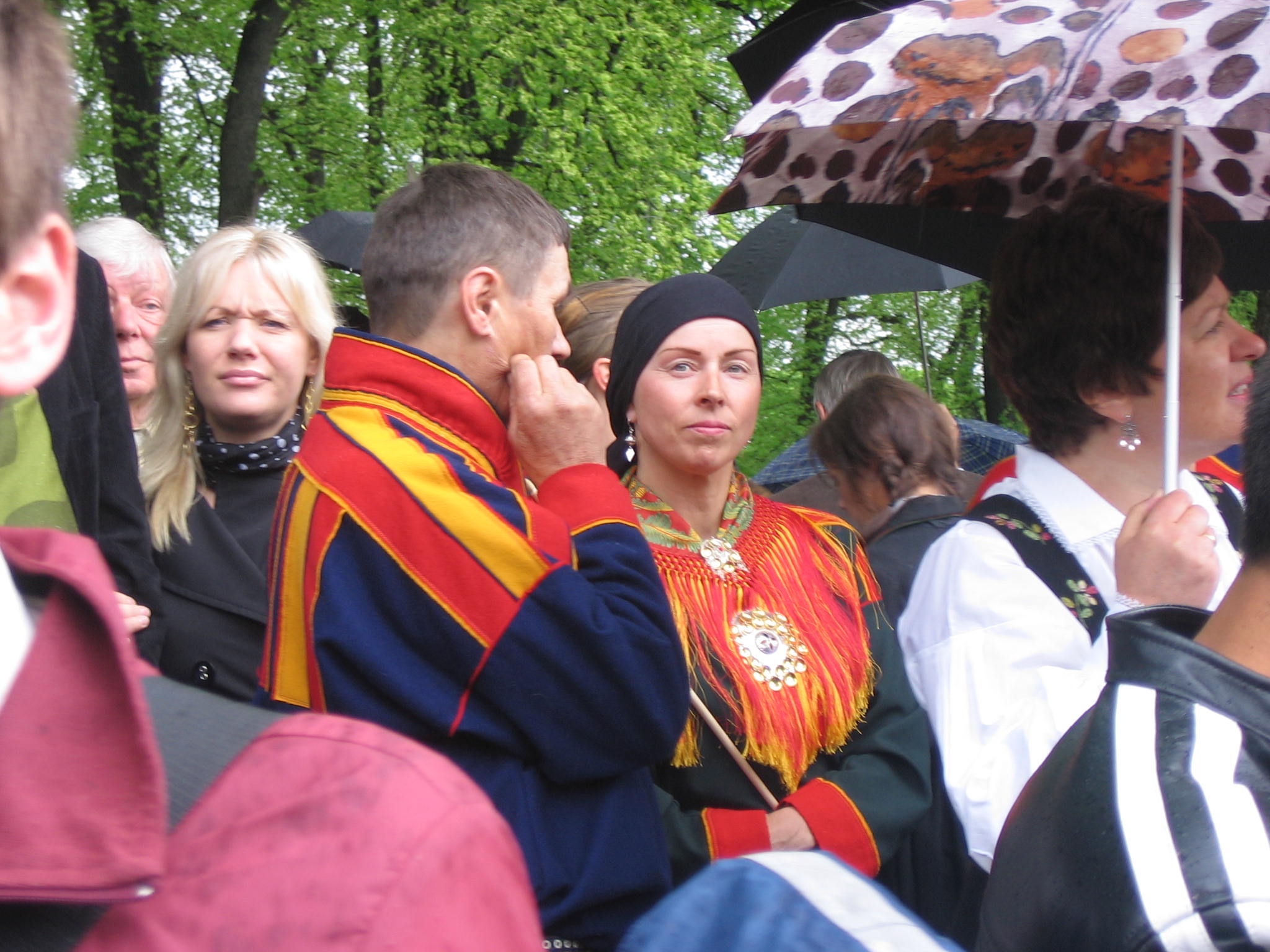Sami Posted by kari on Jun 27, 2009 in Culture, Language
This is a picture of a Sami couple in traditional costume in Oslo on Syttende Mai in 2006.
Upon first glance, this word looks like it could be Japanese, but it is not. The Sami people are the indigenous people that inhabit parts of northern Norway, Sweden, Finland, and Russia. They are among the largest group of indigenous ethnic people in Europe. The Sami speak Sami languages, which are characterized as ‘Finno-Lappic’ languages, part of the ‘Uralic’ language group. ‘Uralic’ languages include Hungarian, Finnish, Estonian, Mari, and Udmurt. If you’ll notice back when I mentioned ‘Finno-Lappic’ languages, you might have thought the the word ‘Lapp‘ is more familiar than Sami. Lapps or Laplanders are deragatory names for the Sami people and unfortunately they are more well-known terms to a lot of people than Sami is. The word lapp means a patch of cloth for mending clothes, which is probably where the deragatory terms came from, describing traditional Sami garb called gatki.
The Sami people of northern Scandinavia and Russia have inhabited these regions for at least 2,500 years. There are several anthropological theories that predict the geographic and cultural origins of the Sami people. One of the theories states that the Sami people orginiated on the Iberian peninsula, their ancestors being the Catalonians and the Basque people. Another theory claims that the Sami people come from the Volga-Ural region. It’s nice when historians discover soemthing and agree on a theory, but I have always thought that it is more fun to entertain the theories and be unsure. Historically the Sami were nomadic people that hunted, fished, farmed, and herded reindeer. Today only the minority of Sami people are nomadic and maintain these forms of livlihood. Roughly half of the estimated 50,000-100,000 Samis today live in Norway.
The traditional Sami religion was based on the shaman, similar to native Americans in the United States. The shaman, or noaidis would enter a trance with the aid of a drum and was able to prophesy and predict future success and welfare of the community. The drum was the link between the people and the gods. The Sami gods were centered around the sun. Prayers and sacrifices were made to Leaibolmmai, the Alder tree man, the god of hunting and animals.
Although Christianity came to Norway in the 13th century, it wasn’t until the 18th century that the religion was pushed upon the Sami people. The Sami began to paint Christian symbols on their drums below the paintings of the shaman gods. Samis also began to attend Christian services on Sunday and practiced the Sami religion at home. Norwegians placed a stronger influence of Christian religion on the Sami by confiscating the rune drums and either burned them or sent them abroad to musuems. Samis who showed visible signs of shamanistic pre-Christian religion were actually criminalized. Norwegian authorities were very clear about the desire to universalize Norwegian culture; they forced the Samis to assimilate into the greater Norwegian culture. Between 1900 and 1940, Norwegian authorities spent a great deal of money on eradicating Sami culture, languages, and Sami education.
After World War II the pressure on the Sami to become/remain assimilated into Norwegian culture was relaxed and there was somewhat of a cultural revival. Today the Norwegian authorities and Norwegians in general actually support the Sami culture as a separate part of Norwegian culture as a whole. Samis are Norwegians too. There are government grants today to promote Sami language, culture, and religion. In Norway, the Sami parliament was established in 1989 and since then, they have been able to democratically elect representatives who see to it that Sami culture, language, education, and industry are regulated and protected.
�

Build vocabulary, practice pronunciation, and more with Transparent Language Online. Available anytime, anywhere, on any device.
About the Author: kari
I attended St. Olaf College in Northfield, MN, where I majored in Norwegian and History. During college, I spent almost a year living in Oslo, Norway, where I attended the University of Oslo and completed an internship at the United States Embassy. I have worked for Concordia Language Villages as a pre-K Norwegian teacher and have taught an adult Norwegian language class. Right now, I keep up by writing this Norwegian blog for Transparent Language. Please read and share your thoughts! I will be continuing this blog from my future residence in the Norwegian arctic!





Comments:
Nancy Adlman:
Is there a Sami Shaman or someone who I can mentor with in the NYC area or who i
can communicate with to learn more about Sami culture, music, healing traditions. I
had the honor or working with a Tuvan throat singing group for a couple of years
when they would travel to the US. I am a Shamanic practitioner and feel drawn to
Norwegian culture. My paternal grandmother was Welsh and my
maternal grandfather was Hungarian. I have integrated psychotherapy and
Shamanism with clients for the past 14 years and i am constantly studying different
indigenous cultures and spiritual traditions.
Thank you.
Nancy Daktoa Adlman, LCSW
Sugeng K:
I am javanese. I don’t speak English. I am soory. I have a question : How much language in Norway?
Thank.
Julian Knott:
Hi
I am currently designing a case study on the Saami for a non-profit organisation and was wondering whether I could use the photo here within it.
Thanks
Julian
kari:
Julian-absolutt!
Julian Knott:
Great, I will put your name in the copyright. Thanks again!